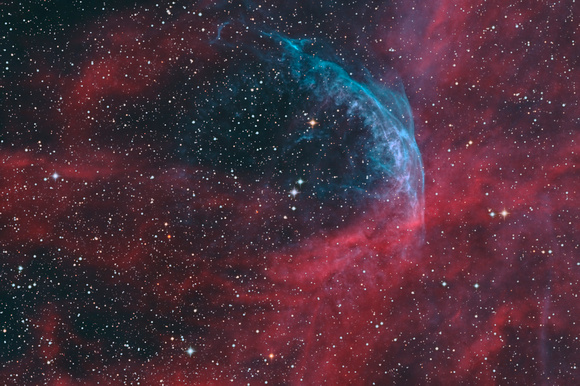Wolf Rayet 134 Star in HOO (RGB Stars)
Wolf Rayett (WR 134) in HOO w RGB stars (Cygnus) - June4,5, 2023
Planewave CDK12.5 - AIS6200MM
A-P 1100 AE GTO, Antlia V pro 3nm NB filters
H,O: (22, 20 x 540s exposures, Bin 2x2, Gain 200)
R,G,B: (15, 15, 15 x 180s exposures, Bin 2x2, Gain 100)
Total Integration Time = 8.6 hours
Wolf Rayet stars represent an maturation path that can be taken by super giant stars that doesn't directly end in a super-nova. Once the hydrogen has been "burned" or shed from these stars, helium, and heavier elements become the fuel du jour. Wolf Rayet stars burn very hot (20,000 to >200,000 degrees C!) and also very brightly - tens to hundreds of thousands of times brighter than the sun. (WR134 is 400,000 times brighter).
The classification of Wolf-Rayet (WR) stars is made depending upon the relative strength of their elemental spectral lines. Helium is most strong, with either carbon or nitrogen taking up second place. Hydrogen is usually very weak or absent. WR 134 here is a "nitrogen" WR star, while the more often imaged Crescent Nebula is the carbon variety.
The intense light radiation from WR also drives heavier element ions from the star that show up as shells, picked up as a blue-green colour ([OIII], [NII] filter) by the camera. Any hydrogen left in the vicinity from molecular clouds, or the previous super-giant phase of the star can also form a bubble, appearing as red (Ha filter). The hydrogen bubble that appears is also lit up by the intense radiation from the WR star.
I believe the actual WR star itself is the second brightest of the two stars most central within the nebulosity.
My goal in this image of WR134 was to see how easily I could capture the entire ring, and hone my HOO processing skills.
To do this I had to substantially boost the faint [OIII] signal (and unfortunately its associated noise) and downplay the Ha signal of the molecular cloud that partly obscures it. The resolution of the shell is great on the RHS of the image, but remains faint and barely visible on the left. I could have done with another (short, summer) night's worth of OIII data. It is also important to maintain the discipline that it is the weakest signal that needs to the most subframes, not the strongest.


